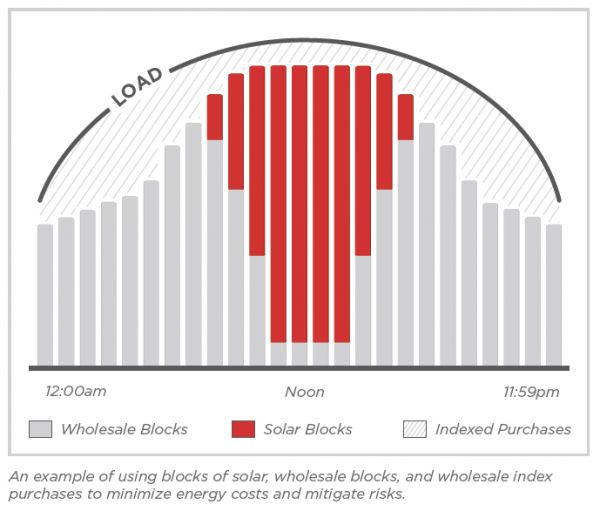The search for funding has led the solar industry down many roads, from the mainstay of state renewable portfolio standard procurements, to the rising driver of voluntary retail customer procurements, to projects enabled through federal PURPA regulations. 7X Energy wants to add a new category -- solar block-and-index contracts.
This week, the Texas-based utility-scale developer unveiled a concept for SolarBlocks, which entails bundling solar projects within the standard retail energy deals available in competitive markets. Built to ensure “additionality,” they're a new way for corporate customers to invest in solar for its energy and regulatory benefits, while keeping their energy bills the same or lower than they are today.
7X’s SolarBlocks will soon be available via yet-to-be-named retail energy partners, CEO Clay Butler said in an interview. Butler is the former head of Texas energy consultancy The Butler Group, and he co-founded 7X in April 2016. Since then, the company has lined up about 4,200 megawatts in its development pipeline, with between 1,000 and 2,000 megawatts set to be in construction next year, he said.
While also engaging in more traditional projects, 7X's new block and index product is a first for the industry, as far as he knows. But the concept behind it -- contracts for energy purchased at fixed “blocks” of time and price, with gaps filled in by “index” purchasing at wholesale market prices -- has been one way that corporate customers have been buying energy for decades now in markets that allow it, he said. The concept just hasn’t been applied to solar until now.
“Up to date, solar developers have been asking customers to do direct PPAs with them, or to do aggregated PPAs,” he said. “Now we can aggregate behind the retailer.”
“The first proof of concept was getting a couple of national retailers to buy in,” he said. “It turns out that lots of their customers are looking for longer-term contracts with renewables to fit them in -- and a lot of them are also looking for additionality.” This refers to solar that wouldn’t otherwise be built, if not for the investment being enabled by the structure in question, and it’s critical for winning the renewable energy credits (RECs) that corporate customers are after, he explained.
Retail energy providers compete in the roughly one-third of the country where there are competitive energy markets, with Texas, Illinois, the mid-Atlantic and the Northeast being the biggest. Many are also connected to generation companies that hold solar and wind farms among their assets, and all are looking at energy markets facing an influx of cost-competitive renewable power.
Solar PV in particular provides its generation over a nicely shaped curve from mid-morning to late afternoon, which happens to fit heat and air conditioner-driven demand spikes and high energy prices in most competitive states. Here’s a chart from 7X showing what that might look like on a typical warm, sunny day.

We’ve covered how companies like Texas-based MP2 Energy use the value of solar’s “shape” to enable its rooftop PV offering with companies like SolarCity. But this is "an industry first, in terms of working with retailers on additionality,” Butler said. That key move opens up these solar megawatts for RECs, while also taking advantage of the solar’s value from the energy retailer's perspective as a hedge against market risk, he said.
It also differentiates its SolarBlocks from other similar-sounding offerings, such as the PowerBloks offered by Energy Edison’s Altenex, which essentially slice up solar PPAs into smaller contracts to meet a broader range of customer demand.
Working with retailer energy providers has also forced 7X to design structures that aren’t too much longer than the 3- to 5-year contracts typical in the industry, he said. That means that SolarBlocks-based contracts will be available for as few as 8 years in duration -- unheard of in the solar PPA world, where most contracts are for 20 years, and “nobody’s gotten below ten,” he said.
Butler declined to get into details about what solar prices enable its SolarBlocks offering in different markets. According to GTM Research's Utility PV Market Tracker, 2016 power-purchase agreements are being signed at values between $35 and $60 per megawatt-hour in a diversified demand landscape.
“There isn’t going to be any markup on the SolarBlocks piece -- we’re offering wholesale pricing. The whole idea is that it has to be competitive. We’re trying to keep the customers’ bill as low or lower.”
The solar blocks concept opens another emerging opportunity in a U.S. solar market, increasingly being driven by alternatives to traditional state RPS-driven procurements. GTM Research found that more than 50 percent of the 2016 project pipeline came from non-RPS drivers, namely: voluntary utility procurement outside of RPS obligations; qualified facility development enabled through the federal Public Utility Regulatory Policies Act (PURPA); and retail customer procurement.
Butler estimated that 7X block and index contracts could open up a significant new market in the form of companies that aren’t quite big enough for their own PPAs, but still have an appetite for solar’s value. “The overall market is much bigger than what we’re talking about today in terms of corporate demand,” he said. “Obviously we’re limited to offering this in retail markets. But in those states like Ohio and Texas, with a liquid retail market, we’re talking like a 4x or 5x factor” in additional opportunity -- a goal that almost meet’s the company’s name.
Join GTM for the 10th Annual Solar Summit & 2nd Annual S3 Solar Software Summit in Arizona May 16-18. We’ve got the biggest names in the solar industry confirmed to attend and speak. And we've got a packed agenda of topics including solar software, energy storage, finance, community solar, corporate procurement, balance of systems, and much more. Check out the event site here.



